Discovering Never-Before-Seen Chinoiserie at Brighton Pavilion and Mastering Its Artistic Beauty

The secret's out
With its magnificent roofline resembling something from a fairy tale, it’s easy to fall in love with the mesmerising brilliance of Brighton Pavilion.
Packed to the rafters with regency splendour, this lavish palace is the former residence of George, Prince of Wales, and, unknown to many, home to one of the biggest collections of chinoiserie decoration anywhere in the UK.
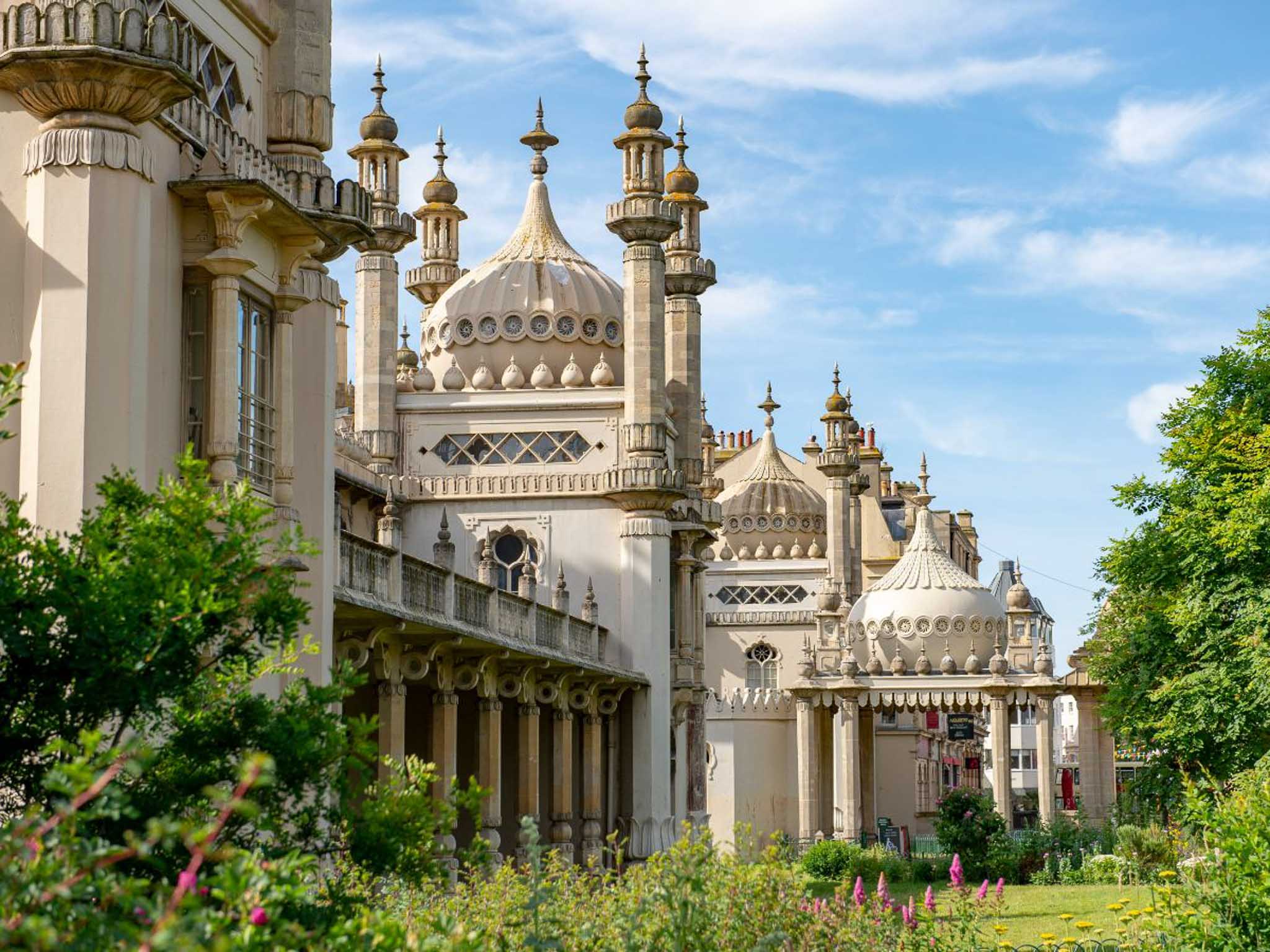
Brighton Pavilion and Gardens
Originally built as Prince George’s seaside getaway, this coastal retreat showcases his fascination with the orient, presenting an interior where imported Chinese furniture and hand-painted Chinese wallpapers take centre stage.
Prince George was a maximalist, long before the term embedded itself into our modern day psyche. His ‘no expense spared’ home flowed with pattern on pattern and colour on colour, all confidently set alongside the boldest of bolds. When it came to decorating, each intricate detail is expressive beyond words, a feast for the eyes, captivating at each angle and every turn.
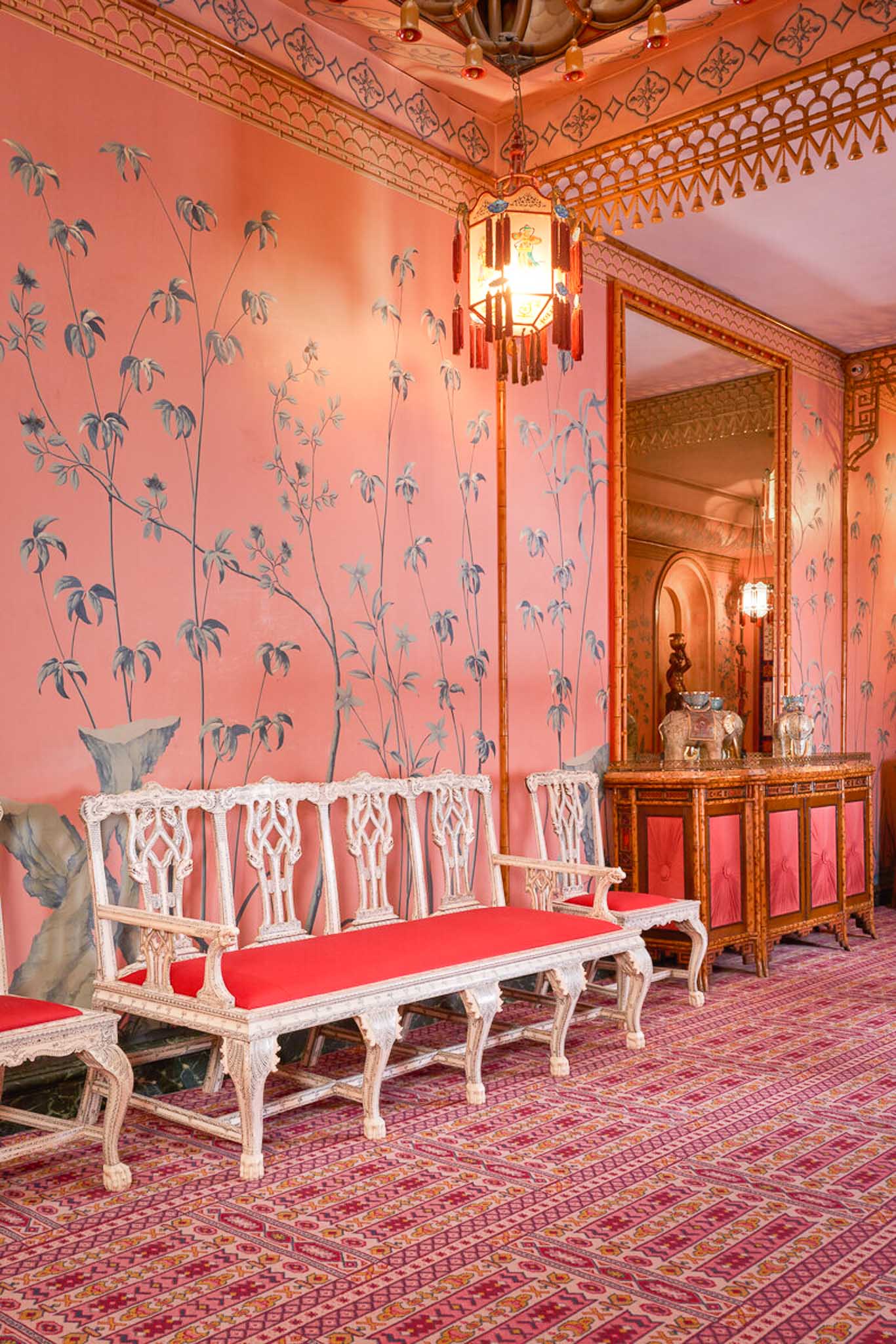
Colourful maximalist interior of Brighton Pavilion
Behind the scenes at Brighton Pavilion
Visiting Brighton Pavilion as a young art student, I was awestruck by so much endless beauty. The palace was undoubtedly the catalyst for my love of chinoiserie and from here on in, its decorative walls have always held a special place in my heart.
Earlier this year, I had the pleasure of meeting with Charlie McKenzie and Dr Alexandra Loske, the art historian and curator at the pavilion. My close friend and fellow artist, Joanna Charlotte came too. We worked together painting a chinoiserie mural for Osborne & Little, and I know she loves chinoiserie just as much as I do, so I had to share such a special treat with her.
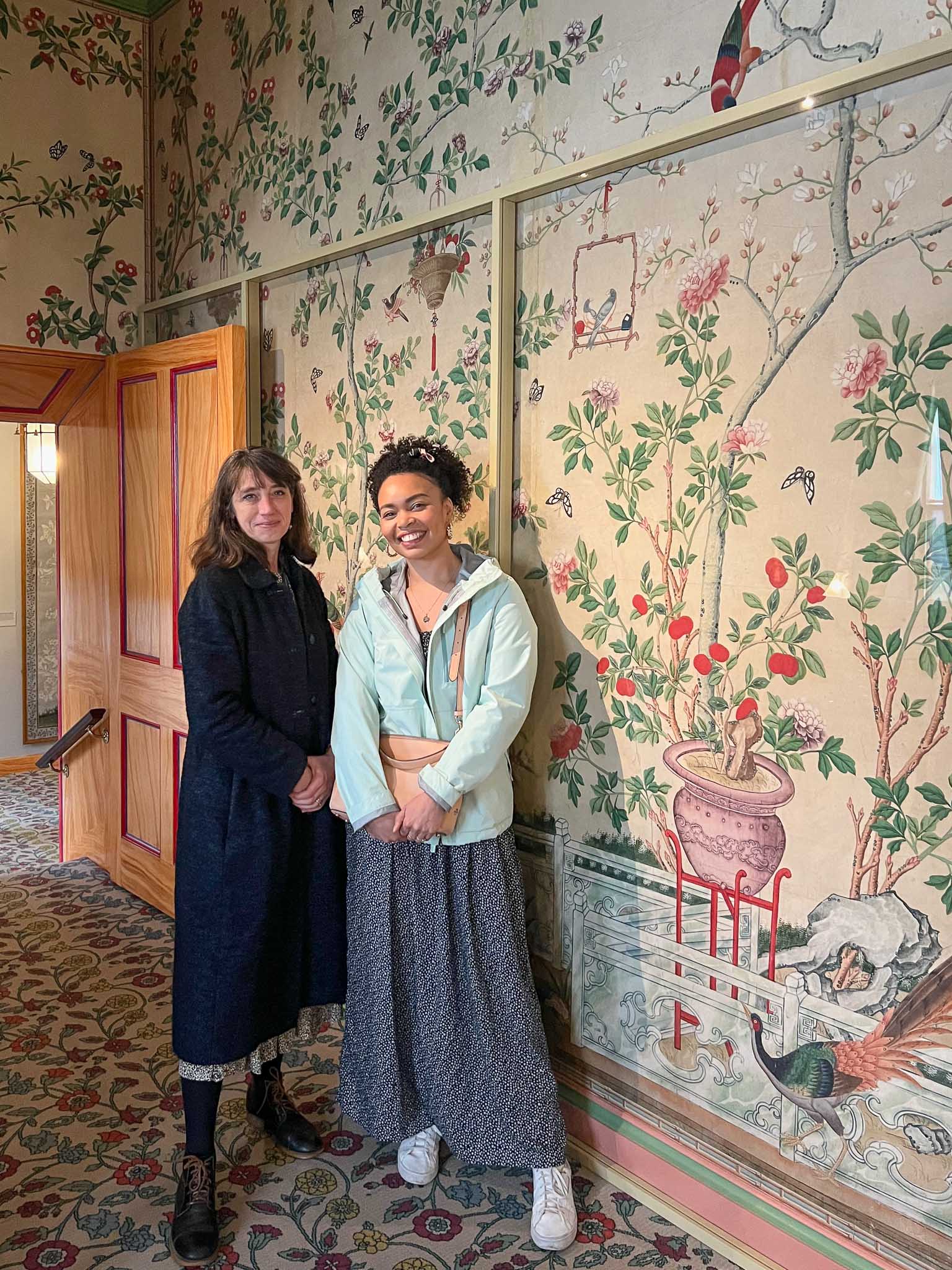
Diane Hill and Dr Alexandra Loske infront of the chinoiserie wallpaper inside Queen Victoria's Bedroom at Brighton Pavilion
Traditionally called Chinese wallpaper, this authentic style of design is instantly recognisable for its beautiful scenes of birds and flowers. More recently, the style has become known as chinoiserie wallpaper, although technically, chinoiserie is a broader term that refers to European interpretations of Chinese and other East Asian influences.
The 18th century artists who painted Chinese wallpapers were never recognised for their work, which was brought to the west for use in grand houses. Interestingly, production processes remain very similar today, where a pattern is chosen and painted (in any colour) to suit the customer’s tastes. It’s fascinating to see this process in real life, as art historians have identified identical sets of the same patterns, in a vast range of colours.
 Chinoiserie wallpaper inside Queen Victoria's bedroom at Brighton Pavilion
Chinoiserie wallpaper inside Queen Victoria's bedroom at Brighton Pavilion
A chinoiserie bedroom fit for royalty
Stepping into Queen Victoria’s dreamy Brighton Pavilion bedroom, I found myself almost lost in time. This room was undoubtedly the highlight of my visit, with its original hand painted chinoiserie wallpaper beautifully restored. I found myself imagining how the queen would feel waking up each morning to such a magical world, greeted by Chinese birds and flowers intricately painted in watercolour.
Unusually, these designs were drawn onto paper and lined with a hessian canvas before being applied to the wall. This technique gave strength to the wallpaper, meaning it could be removed from the wall without too much damage and reinstalled elsewhere.
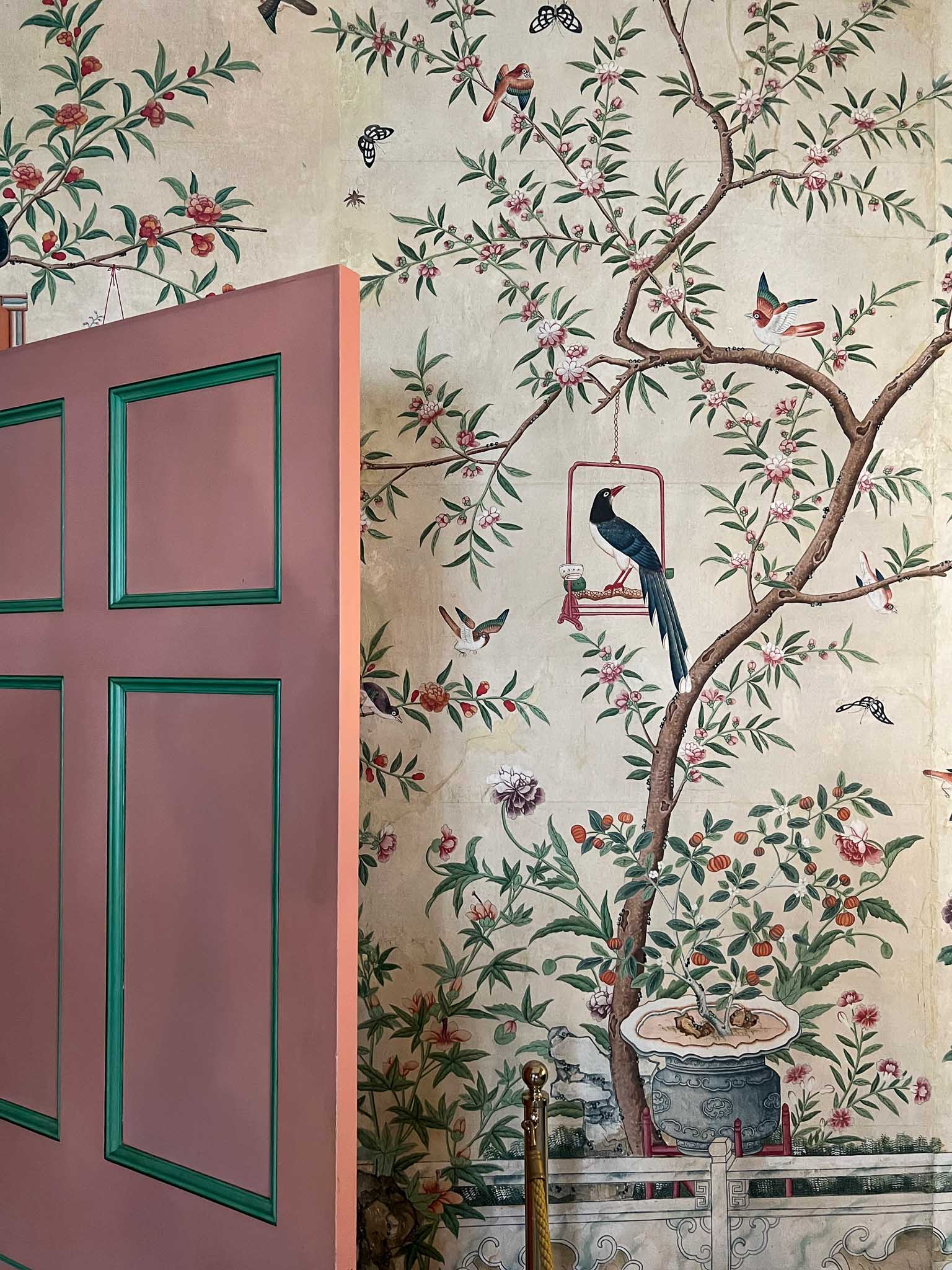
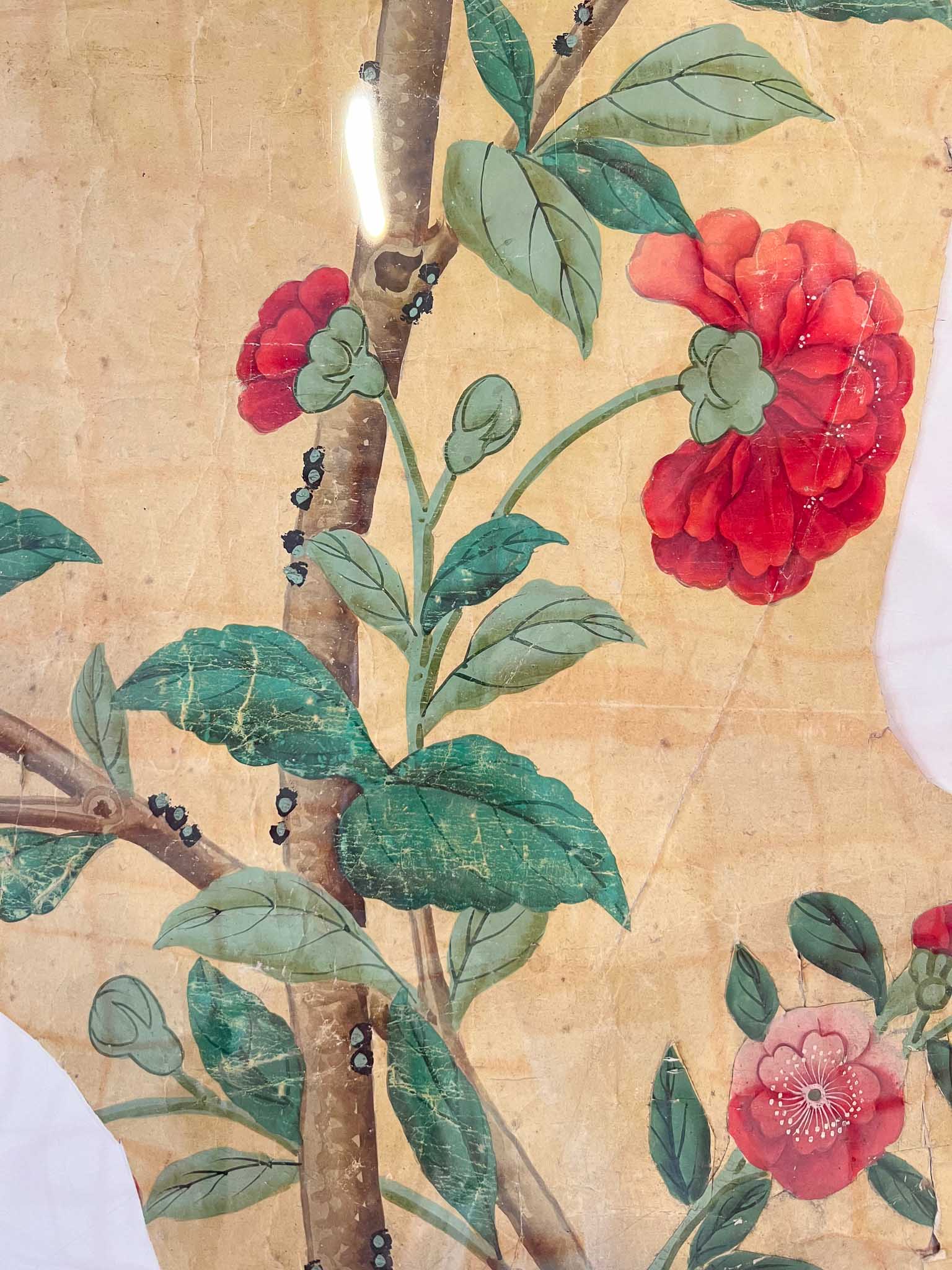
Fragment of chinoiserie wallpaper from Queen Victoria's original bedroom
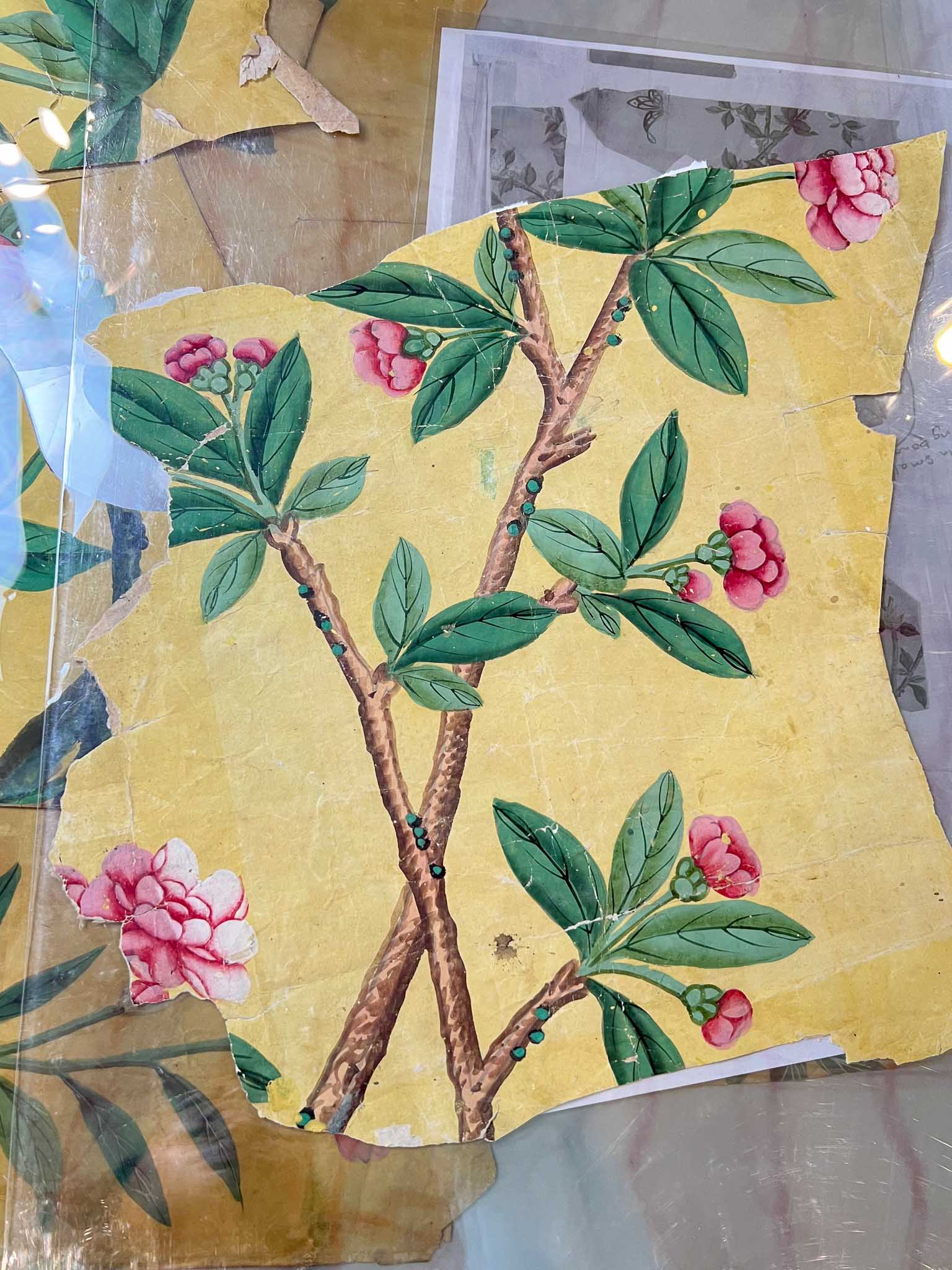
Spare panels of the chinoiserie wallpaper used in Queen Victoria's bedroom
Time for tea
I was so taken aback when the Brighton Pavilion team asked to use my Florence wallpaper in powder blue for their tearoom walls. The area had been closed for years and with reopening imminent, it was decided that Florence would echo the wallpaper of the pavilion’s historic grand staircase, giving an uplifting feel to the new space.
Artists Joanna Charlotte and Diane Hill enjoying their tea in front of the powder blue Florence wallpaper in the tearoom at Brighton Pavilion
I honestly can’t begin to explain what an honour it is to have my chinoiserie wallpaper sitting alongside the original 18th century Chinese wallpapers that inspired me from such a young age. This is definitely one of those moments to treasure forever.
Enjoying tea and lunch in the tearoom at Brighton Pavilion
The main staircase and hallway are two of the most stunning parts of Brighton Pavilion. Painted in a very different and much more European style to the rest of the palace, its colour and aesthetic closely align with my Florence design, which is one of the primary reasons it was chosen for the tearoom.
 Artist Joanna Charlotte at the top of the Grand Staircase at Brighton Pavilion
Artist Joanna Charlotte at the top of the Grand Staircase at Brighton Pavilion
Learn to paint on silk paper
Want to try painting on silk paper? Whether your sights are set on creating a unique piece of wall art or you’re just starting out, I have sheets of silk that are perfect for watercolours or gouache paint. In a choice of sizes, there’s something for everyone and for all levels of ability.
Diane Hill hand painting onto chinoiserie designs onto silk paper for Harlequin, available here!
I painted every stroke of Florence on to silk, which was then translated ready for wallpaper production.
Diane Hill with her original painting of her Florence Wallpaper
Painting on silk has added a whole new dimension to my artwork, achieving levels of detail I never thought possible. An ancient Chinese tradition dating back to 476 BC, silk was considered the purest and most valued material available at the time, with bespoke artworks commissioned by emperors and members of high society. Painting onto silk in paper form remains a rare and unique technique.
Diane Hill hand painting the beautiful peacock featured in her Florence wallpaper onto silk paper
How to create a chinoiserie scene
Creating an authentic chinoiserie look requires a carefully considered selection of composition, style and colour, with each element coming together to build a classic scene.
Trees and their individual composition are so integral to the overall design, and I study a variety of original compositions to get all my own ideas. Typically, chinoiserie scenes are made from a row of trees that spread out wider at the top and nearer the ground, with smaller shrubs like peonies or fruits, as well as decorative pots, ornate fencing and trellis adding further detail. Open spaces are filled with butterflies or birds and many tree branches intertwine to give a natural feeling.
Initial chinoiserie design by Diane Hill and the finished design in colour
Painting a range of trees, plants and flowers is what chinoiserie is all about. It’s what makes chinoiserie so special and bespoke - nothing repeats, and each element is unique, just like a garden. There is interest everywhere you look and using lots of different colours enhances a feeling of paradise.
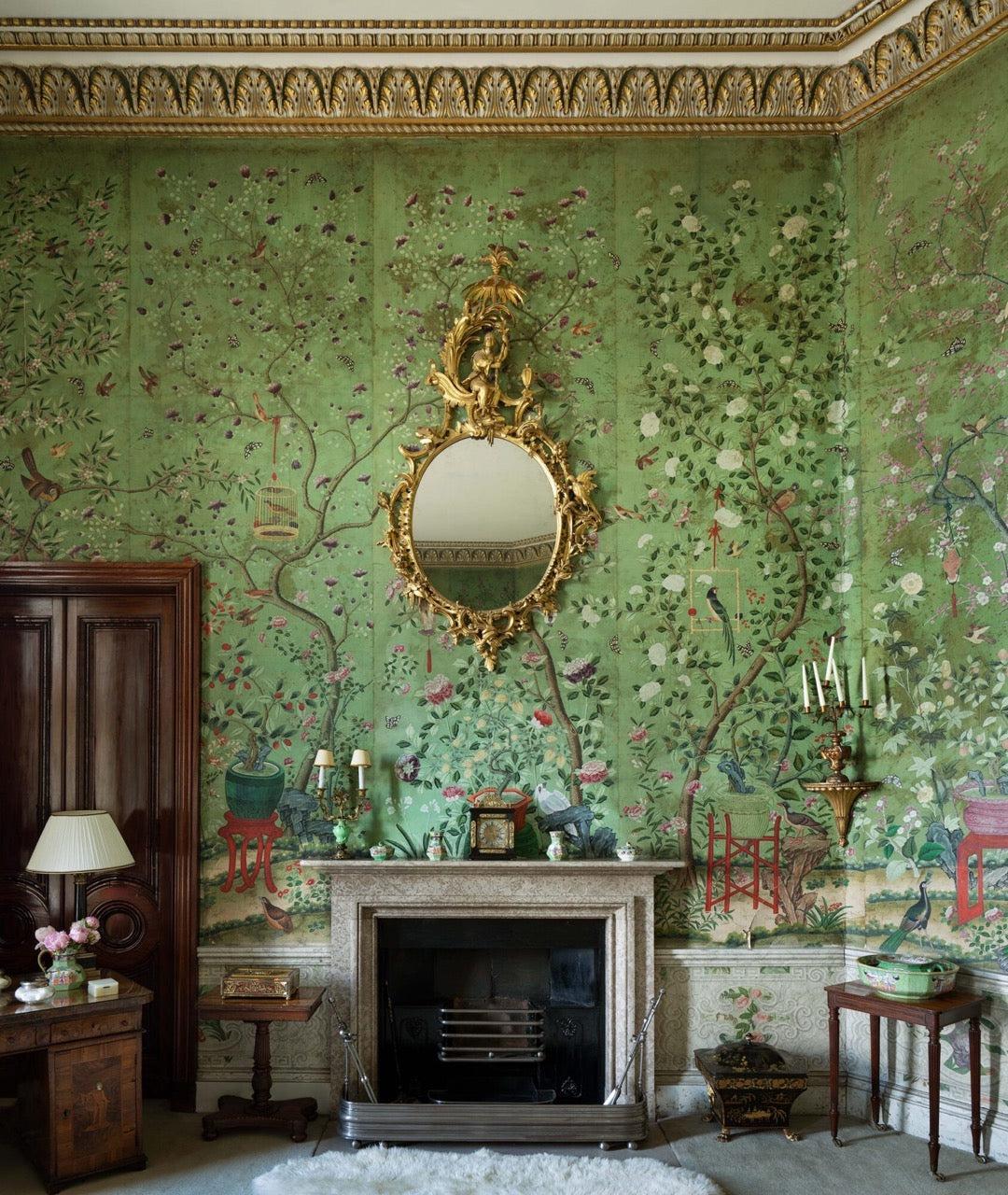
Photograph of chinoiserie wallpaper from Belvoir Castle
Chinese artists traditionally painted birds in pairs to represent harmony, placing them at different heights to bring a compositional interest to the design. The birds’ sizes vary, with some so tiny they are almost hidden among the leaves and others more dominant, swooping with outstretched wings.
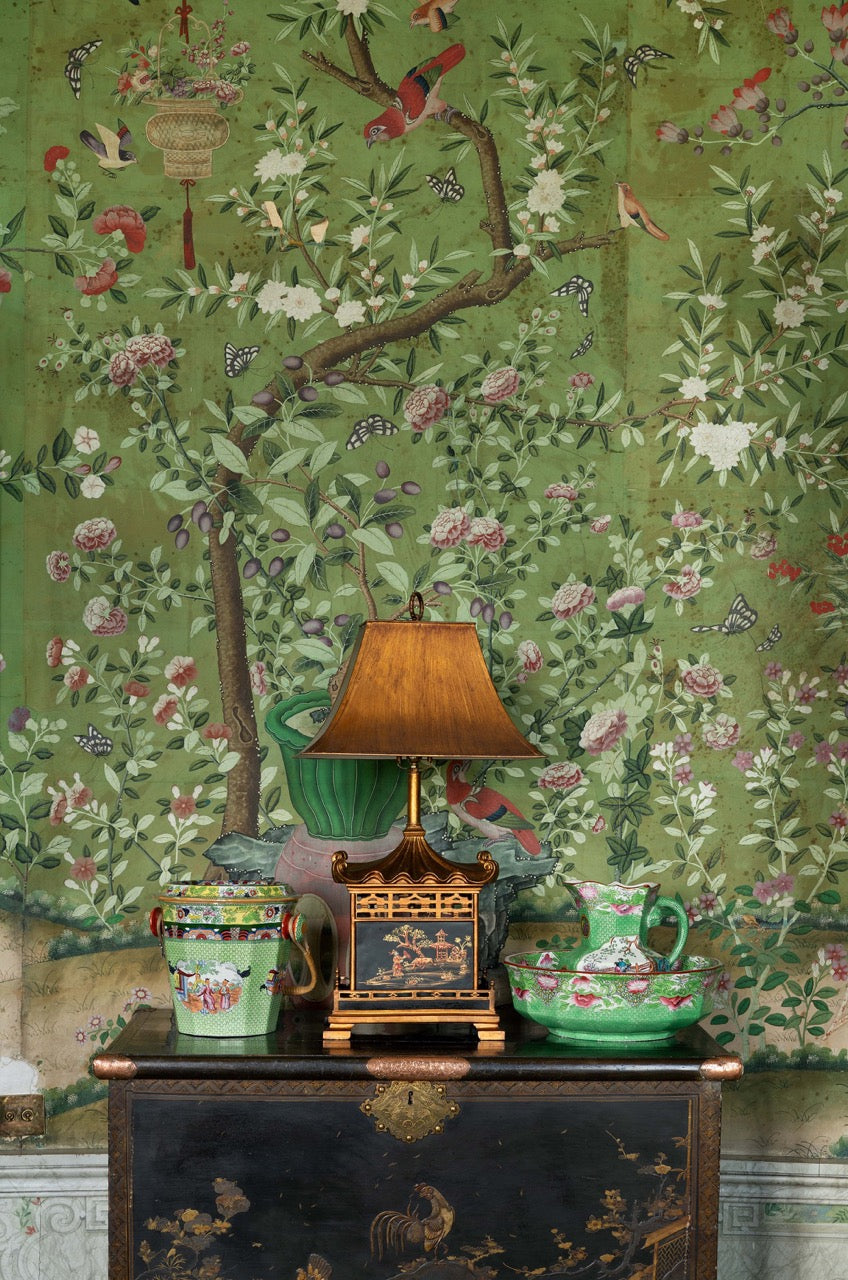
Beautiful green chinoiserie wallpaper at Belvoir Castle
Chinese wallpapers were not intended to look like a realistic painting, because there’s no depth or background layers. Instead, they have their own quirky style, which is what makes them so special and unique. For example, even the fence in this image is odd in its placement and even (dare I say it!), slightly jarring.
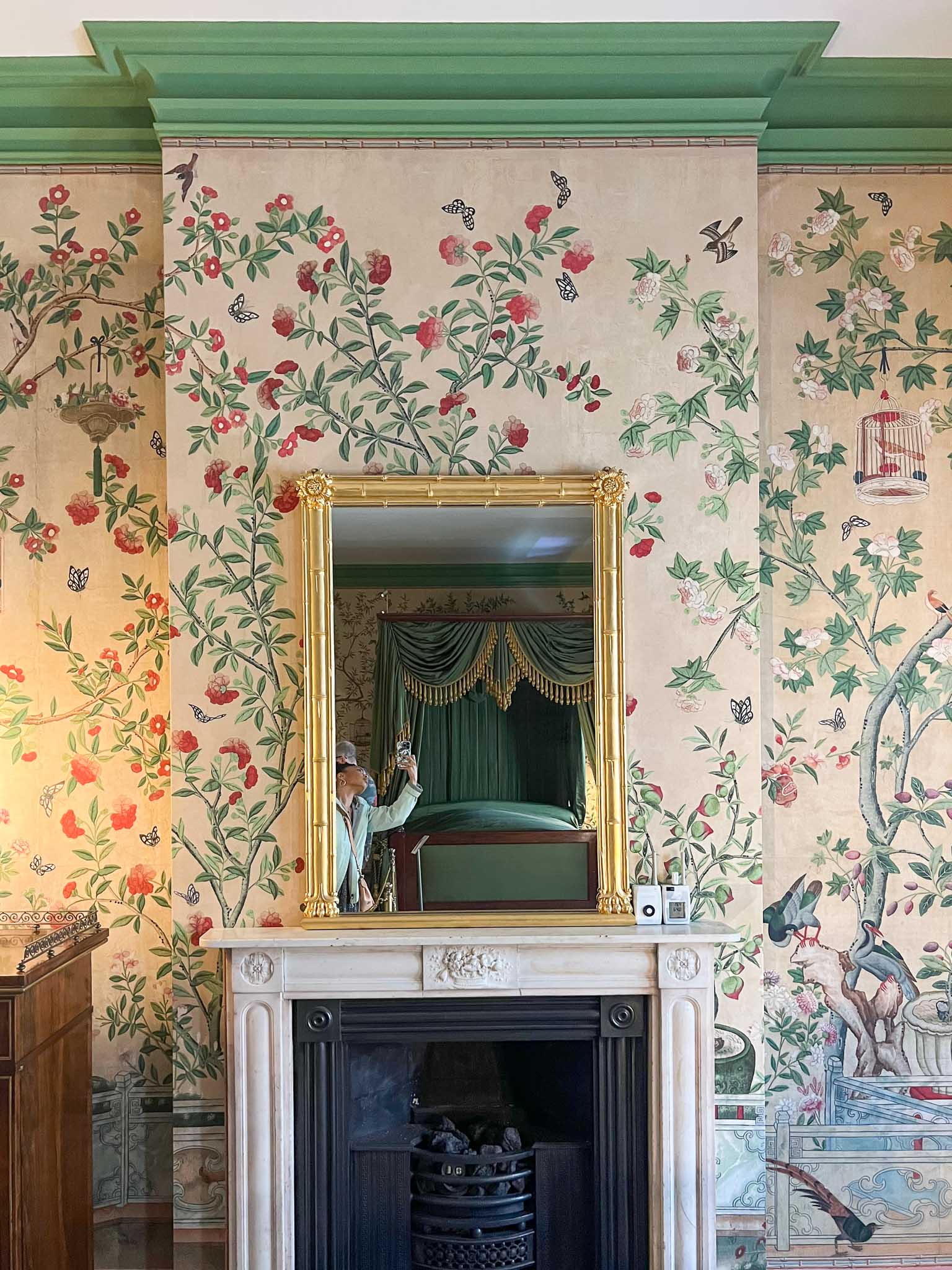
Chinoiserie wallpaper in Queen Victoria's bedroom at Brighton Pavilion featuring a fence
In this example, leaves repeat over and over – it’s all the same single layer of paint, with small shadows and detail. Remember that chinoiserie leaves aren’t supposed to look real and are instead intentionally stylised. That said, there’s lots of shading within each element, so it almost juxtaposes with the flat ‘pattern like’ overall scheme.
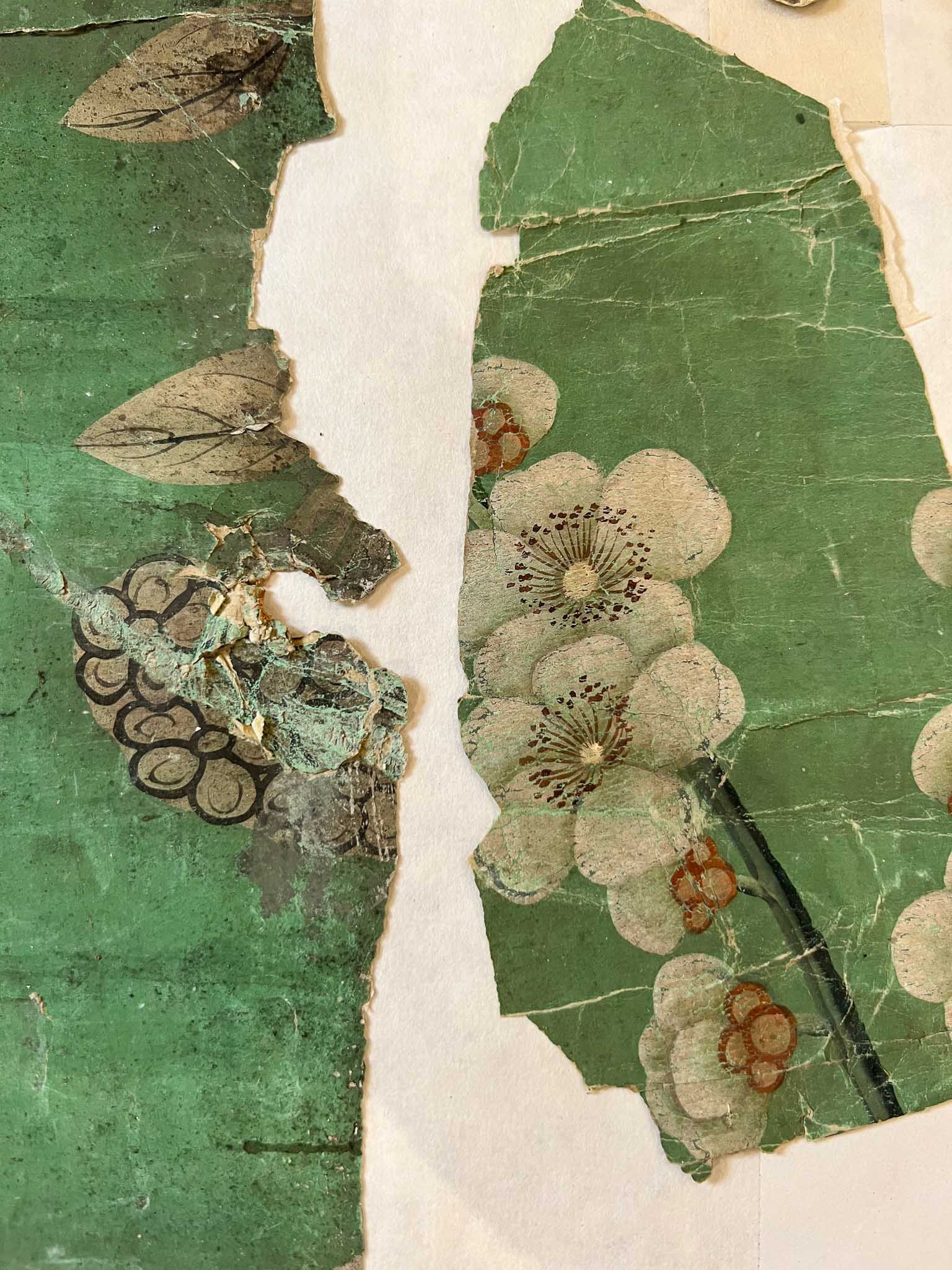 Archive documents of chinoiserie wallpaper panelling
Archive documents of chinoiserie wallpaper panelling
To me, this is what gives chinoiserie such classic timeless beauty. The mixture of pattern and realism are so captivating and interesting to the eye. The way traditional painters achieve shadows in the flowers is also fascinating – it’s like they put a ruler across the flowerhead and shade one half and leave the other half light. It’s really does draw you into the story in a way that’s brilliantly dramatic and endlessly enticing.
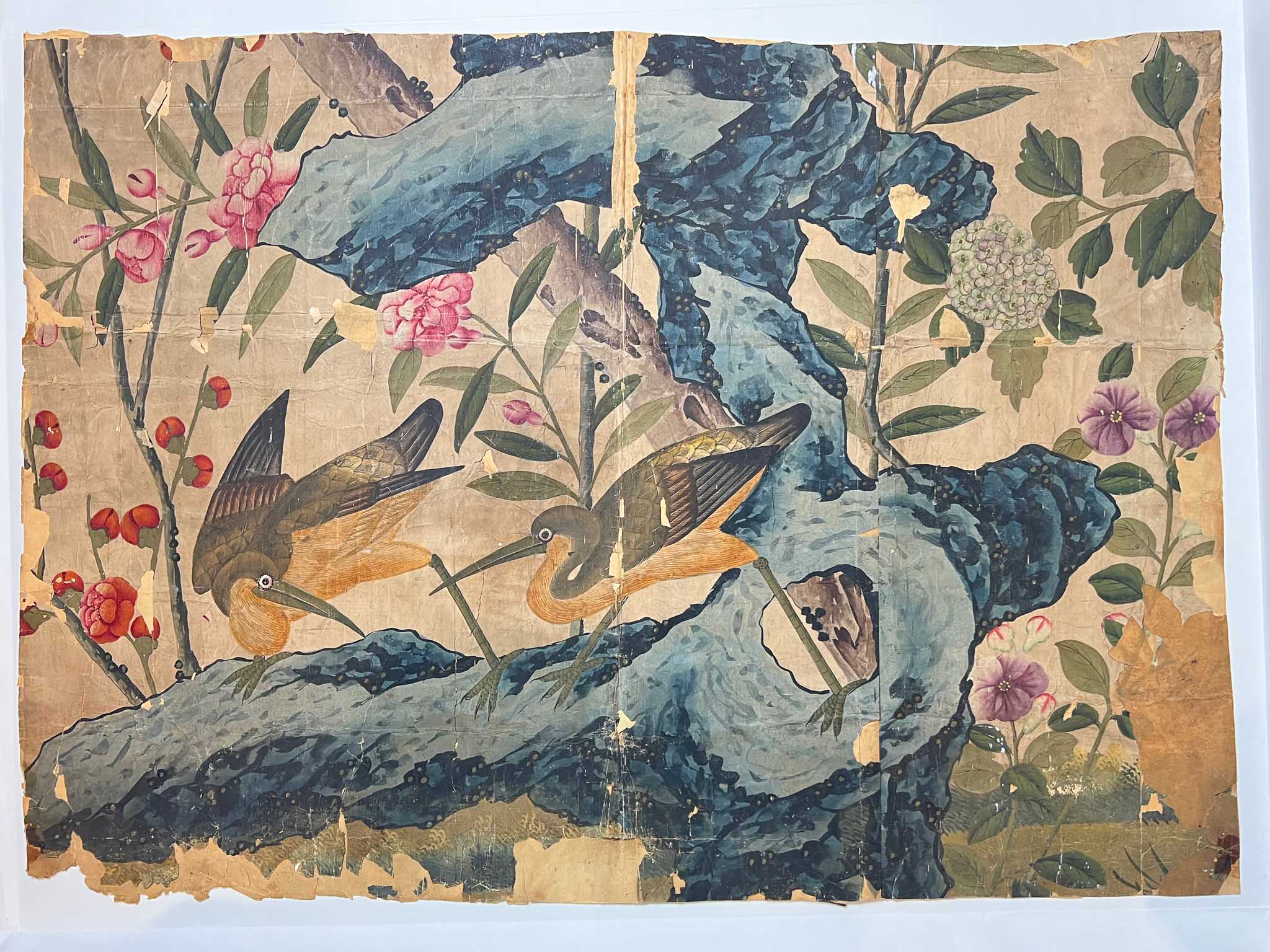
A photograph of chinoiserie wallpaper from the Brighton Pavilion archives
Rocks feature throughout chinoiserie wallpaper in many weird and wonderful ways. Irregular shapes, created by gorgeous brush strokes and shading give a rocky texture, as shown in this example from the Brighton Pavilion archives of two beautiful birds perched on a blue rock fragment.

An archive document of chinoiserie painting with a stylised pomegranate
Chinese wallpapers were often created with a white silhouette and black line detail. This archive document shows a stylised pomegranate, beautifully painted in full colour standing proudly against white, flat foliage on a contrasting green ground. Just like this beautiful grey panel where there is a mixture of white foliage and full colour painting.
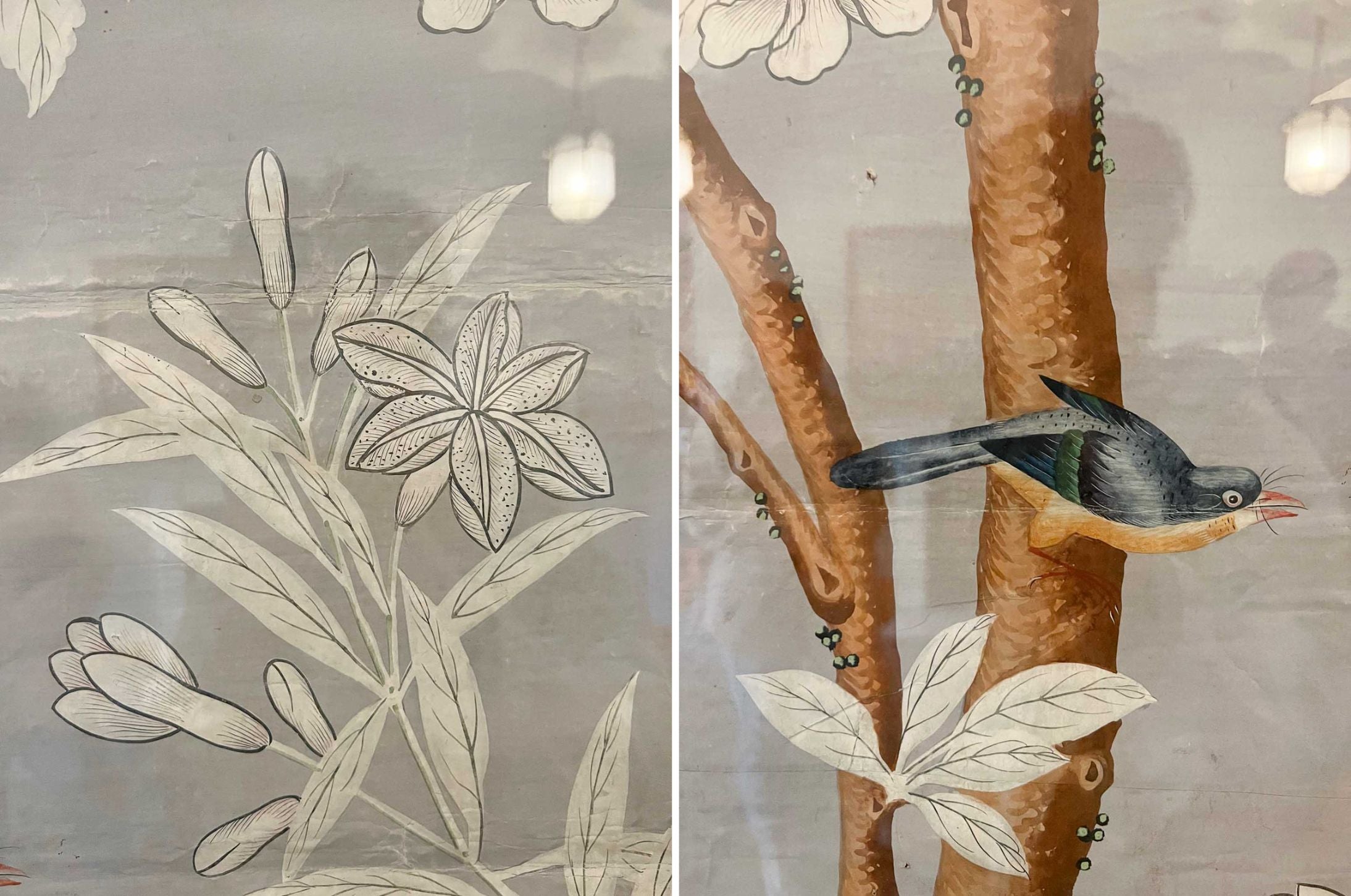
Photographs of white foliage background and a colourful bird from a hand painted grey chinoiserie panel at Brighton Pavilion
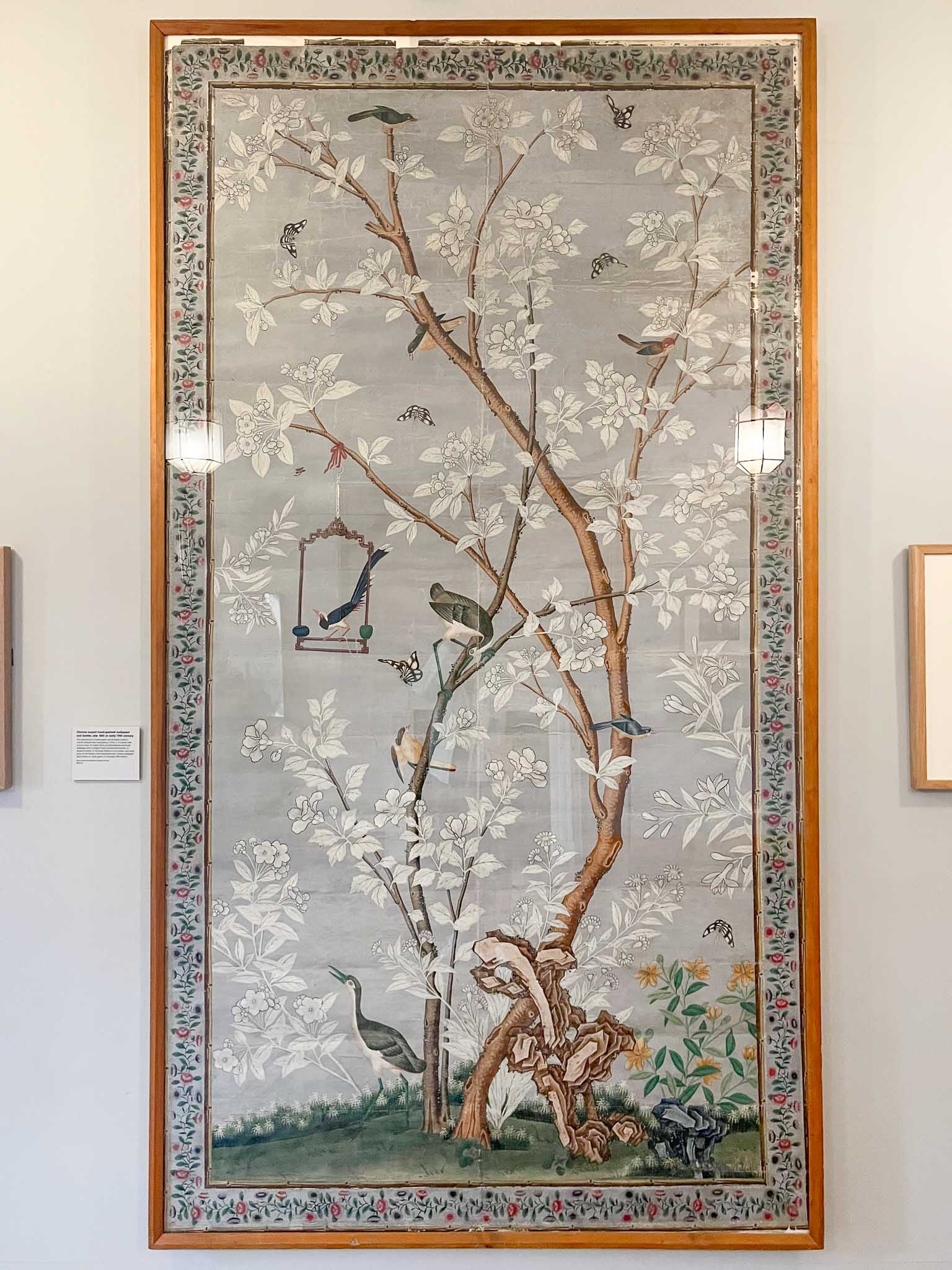
Photograph of a hand painted grey chinoiserie panel Brighton Pavilion
Pioneering personalisation – bringing a whole new meaning to collage
I couldn’t finish this blog without including a fun fact that I discovered while visiting Temple Newsam, the Jacobean stately home in Leeds.
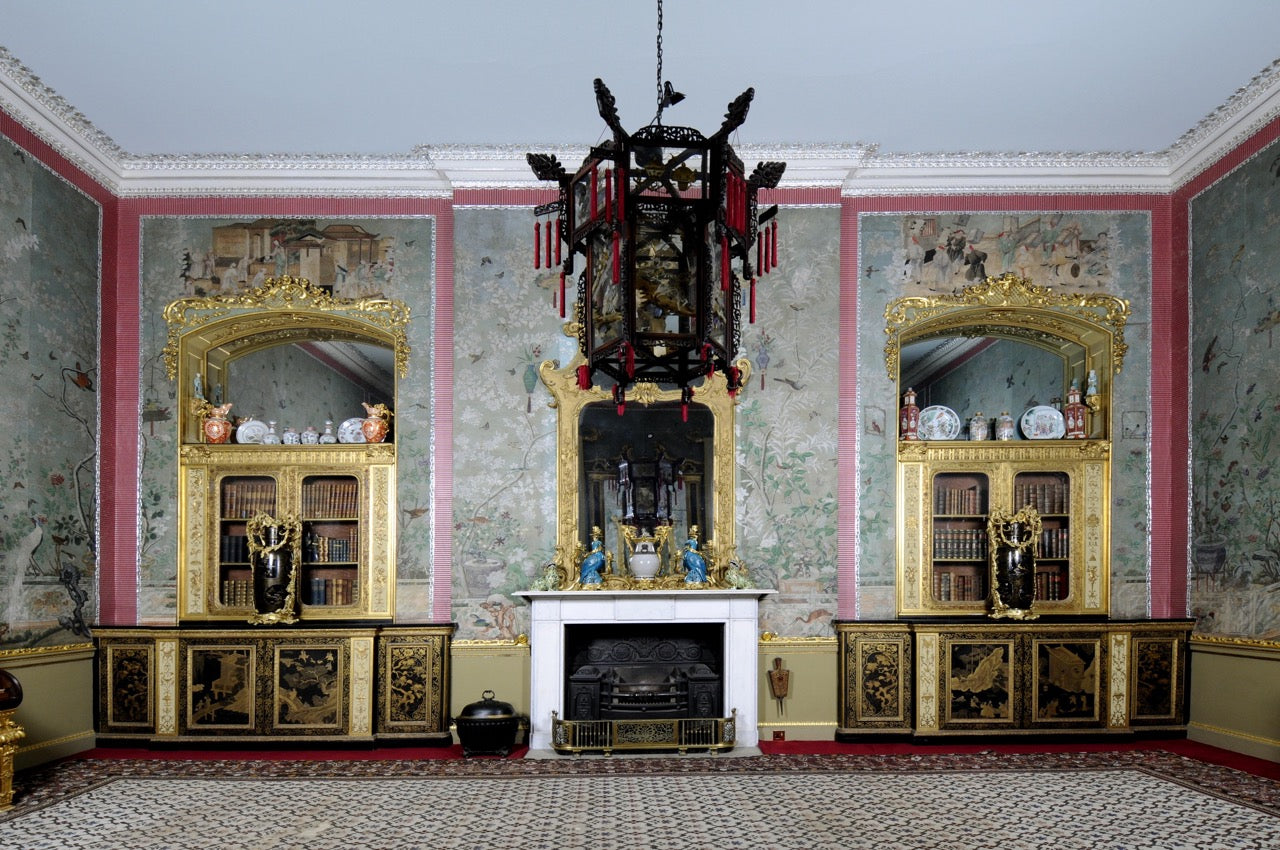
Temple Newsam Chinese Drawing Room
On updating her drawing room with the hand-painted Chinese wallpaper gifted by George, Prince of Wales many years before, Lady Isabella Hertford decided her new look interior needed a touch more detail. Armed with scissors, she set about cutting some new feathered friends from John James Audubon’s highly acclaimed book, The Birds of America, resulting in life-size birds flying alongside the paper’s original Asian residents.
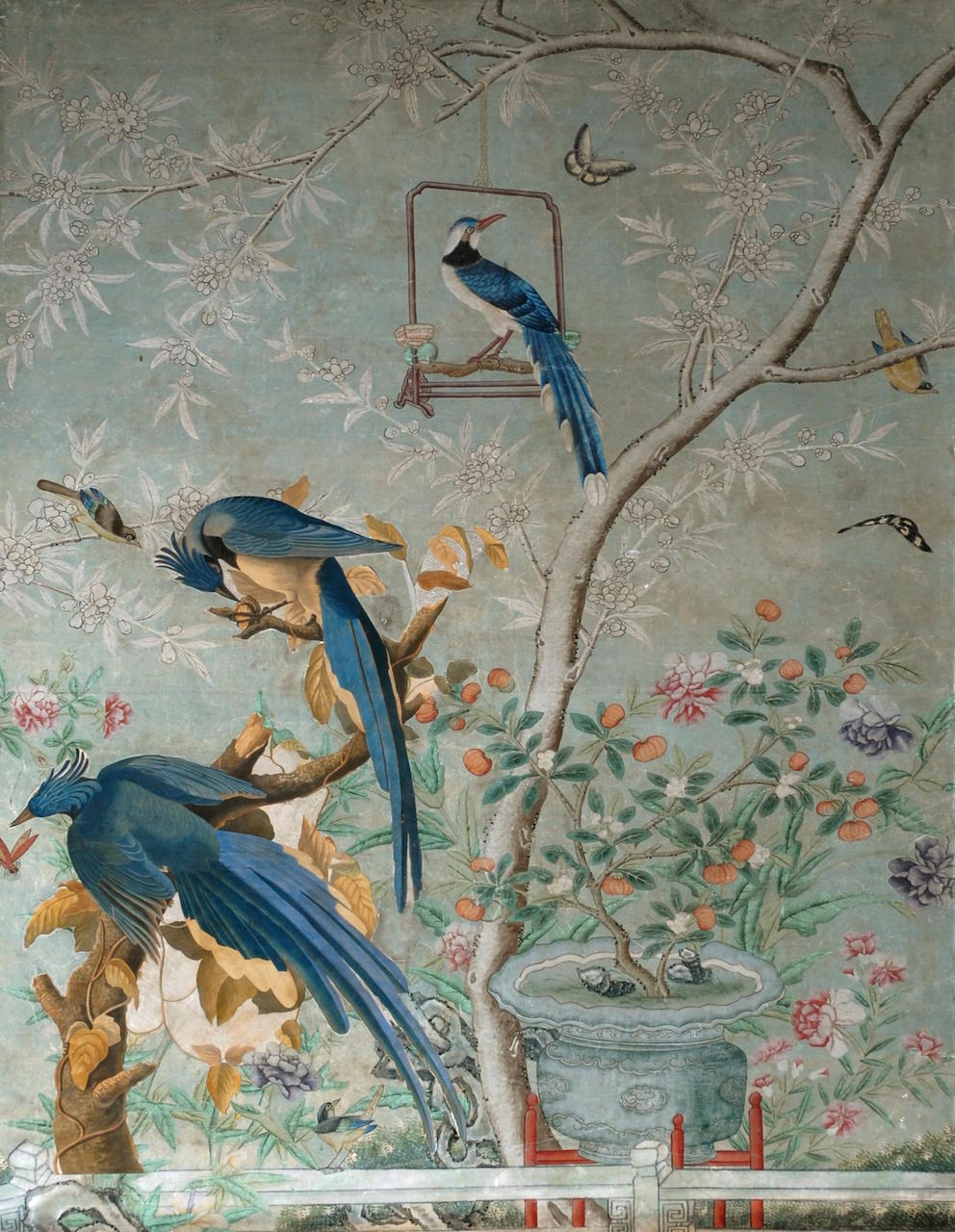
Wallpaper from the chinese drawing room with cut out birds
In a manner slightly less extreme, pieces of paper, often containing birds or perhaps a length of branch, would be cut out by wallpaper hangers to cover marks, which you can see in this image, where a few leaves have been removed and rehomed.

Panel of the chinoiserie wallpaper from Queen Victoria's original bedroom at Brighton Pavilion
This is a technique we still use today, and I have been asked to touch up chinoiserie wallpapers using methods just like this in all corners of the world!!
Much remains unknown about Chinese wallpapers, such as exact production methods or those who painted them. Their creation by dedicated artists has remained unchanged for centuries, with modern day artisans following in the same footsteps of exacting standards and a dedication to preserving this unique and complex artform.
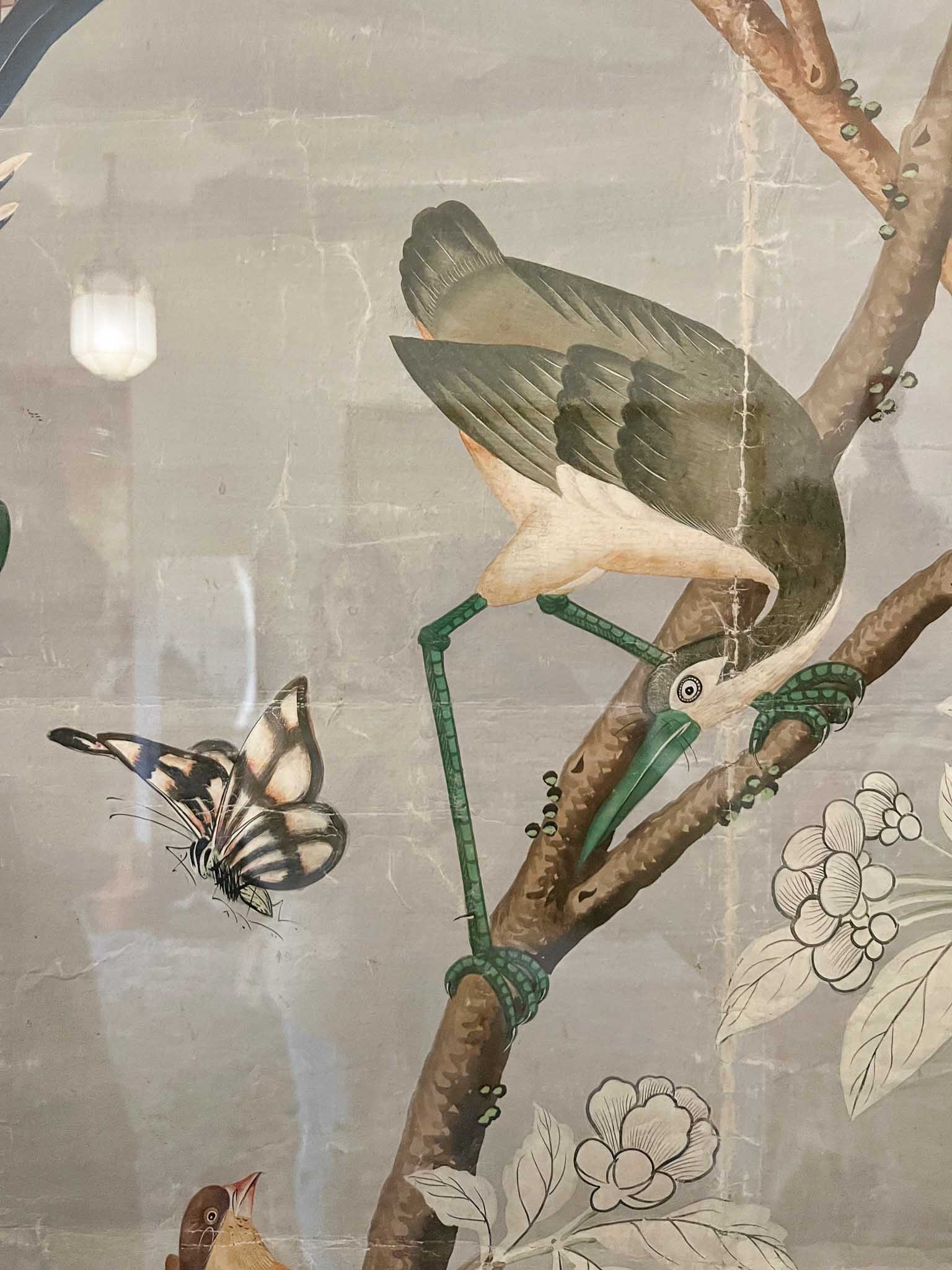
Hand painted bird featured on the grey panel at Brighton Pavilion
My thanks go to Emile de Bruijn, the grand master of chinoiserie, for connecting me with the team at Brighton. The author of ‘Chinese wallpapers in Britain and Ireland’, he knows everything there is to know about chinoiserie and to receive an acknowledgement from the man himself is a true honour!
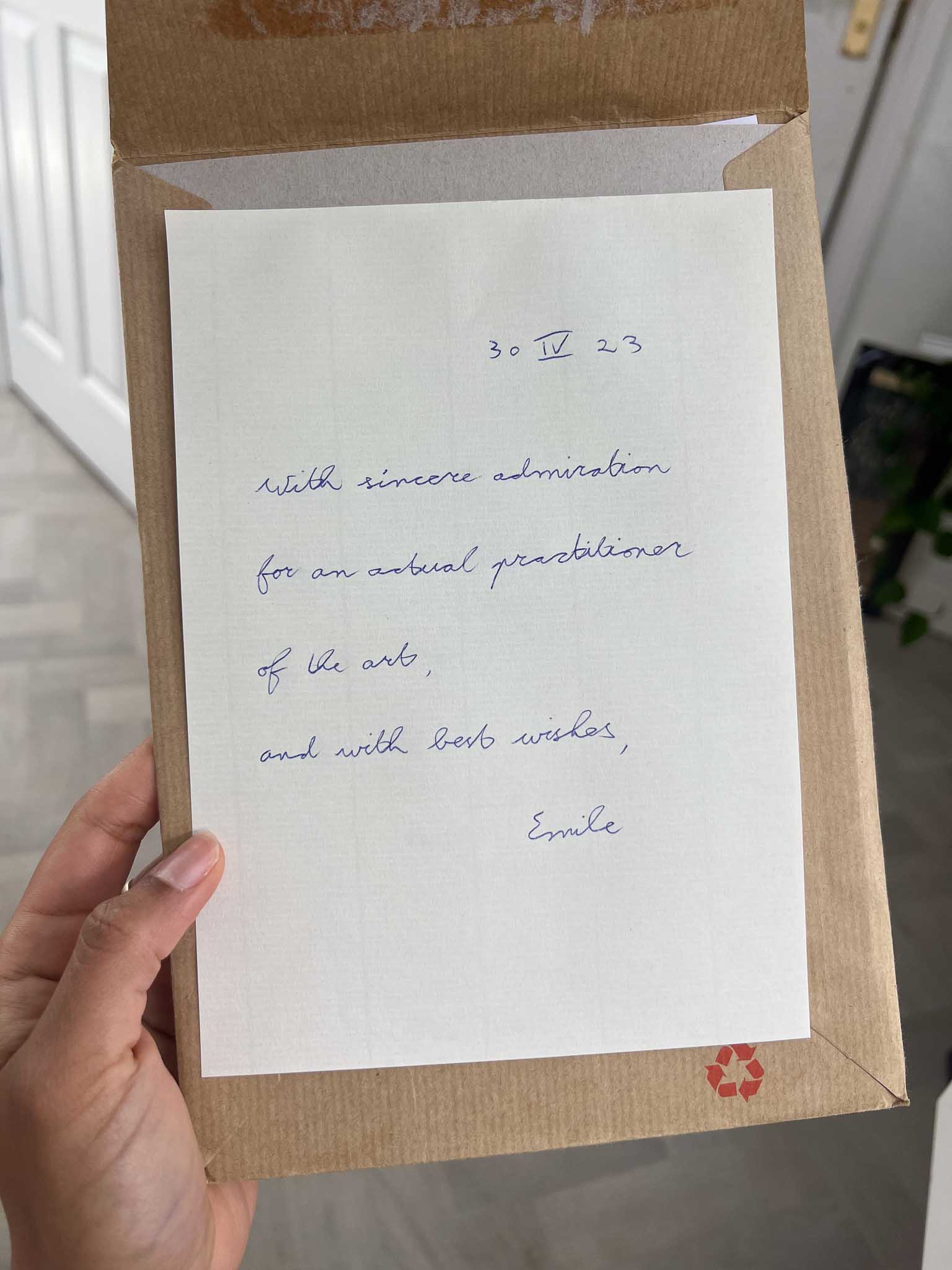
A handwritten letter to Diane Hill from Emile de Brujin
I hope you found this as interesting as I did! If you'd like to learn more about the history of chinoiserie wallpaper and what it means then click here!
Love this style?
If you're an artist and you love this style of painting then be sure to sign up here to learn more! An exciting course is coming soon and you will be sent tips and techniques to master this paint style yourself.



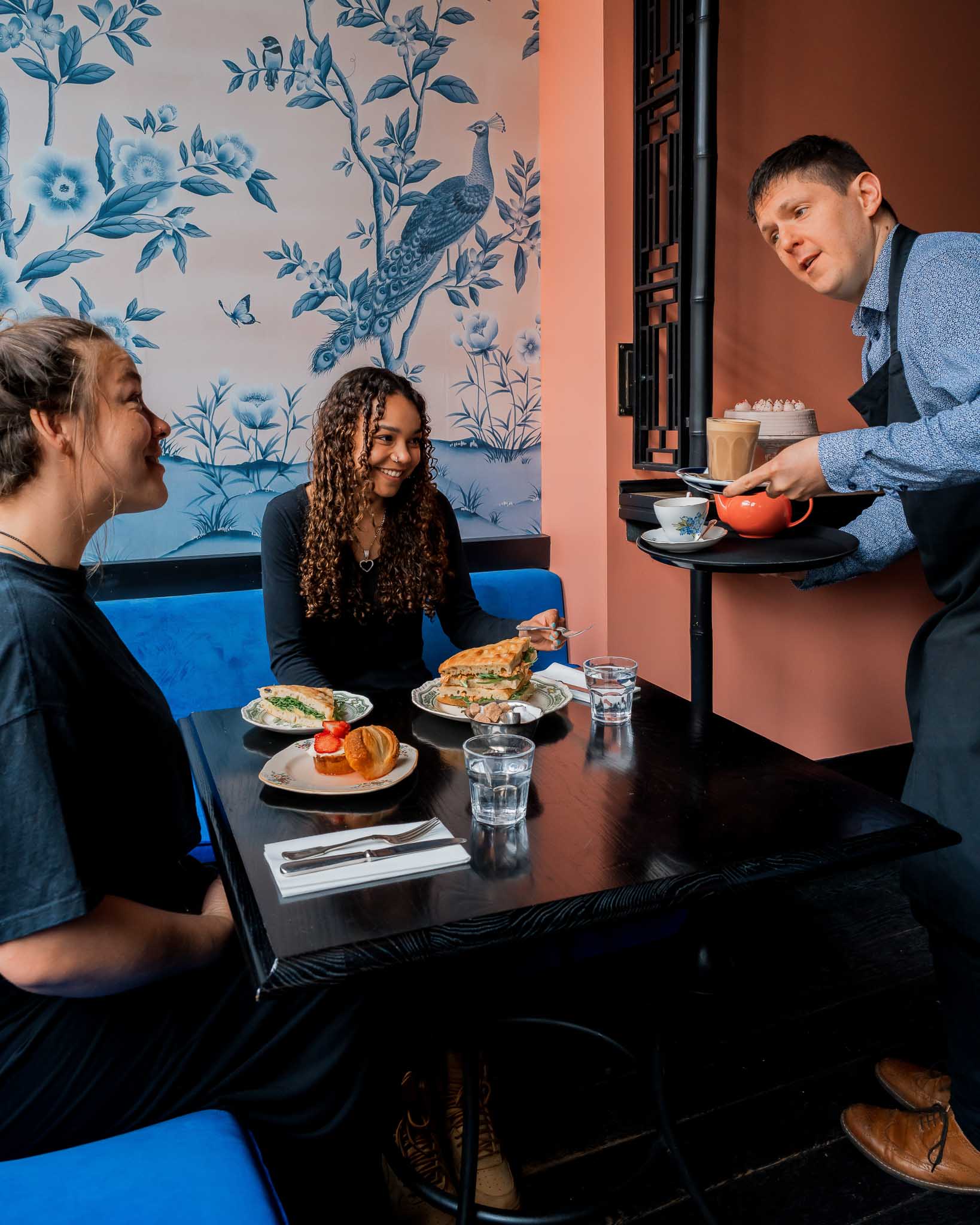


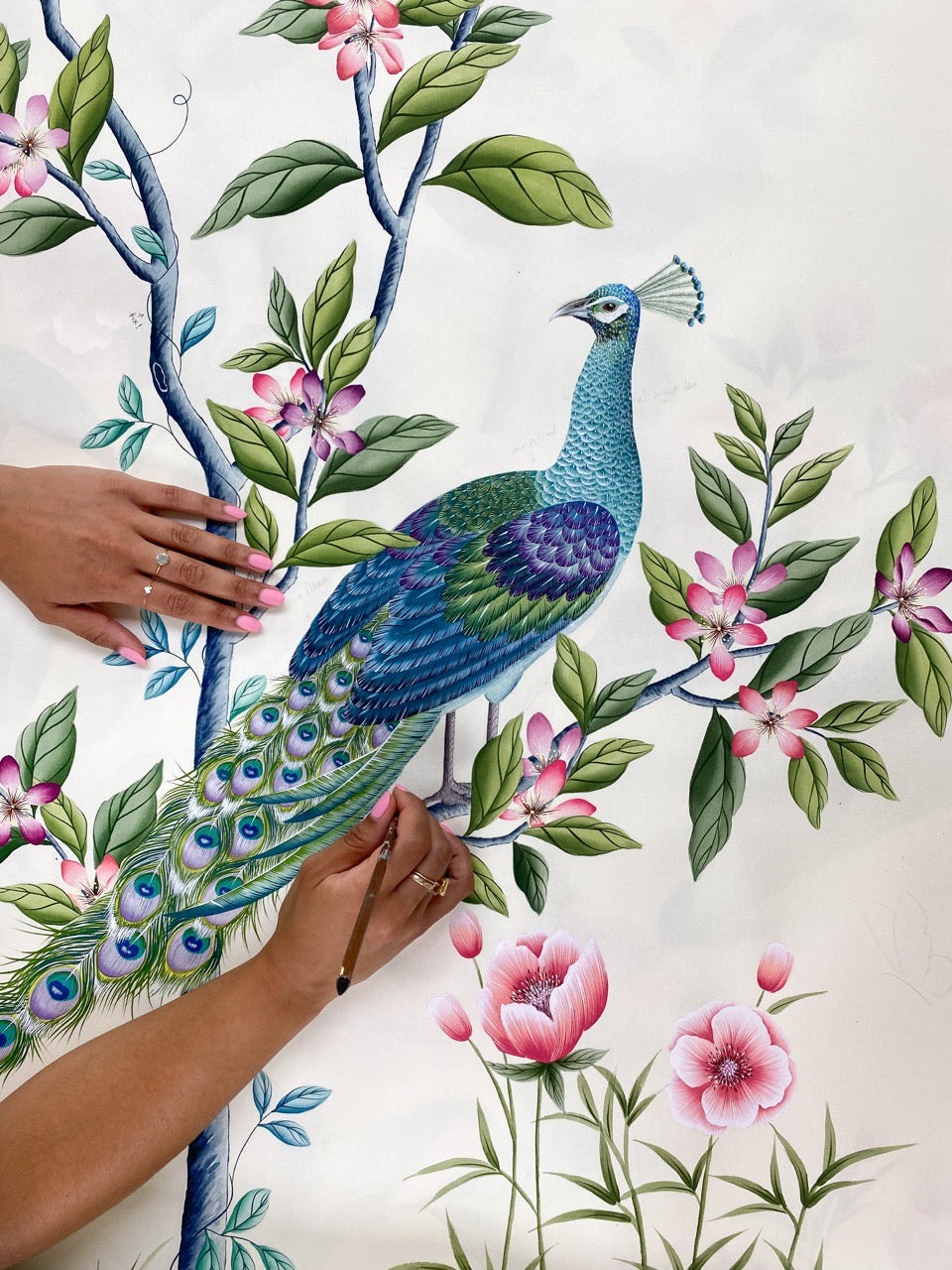
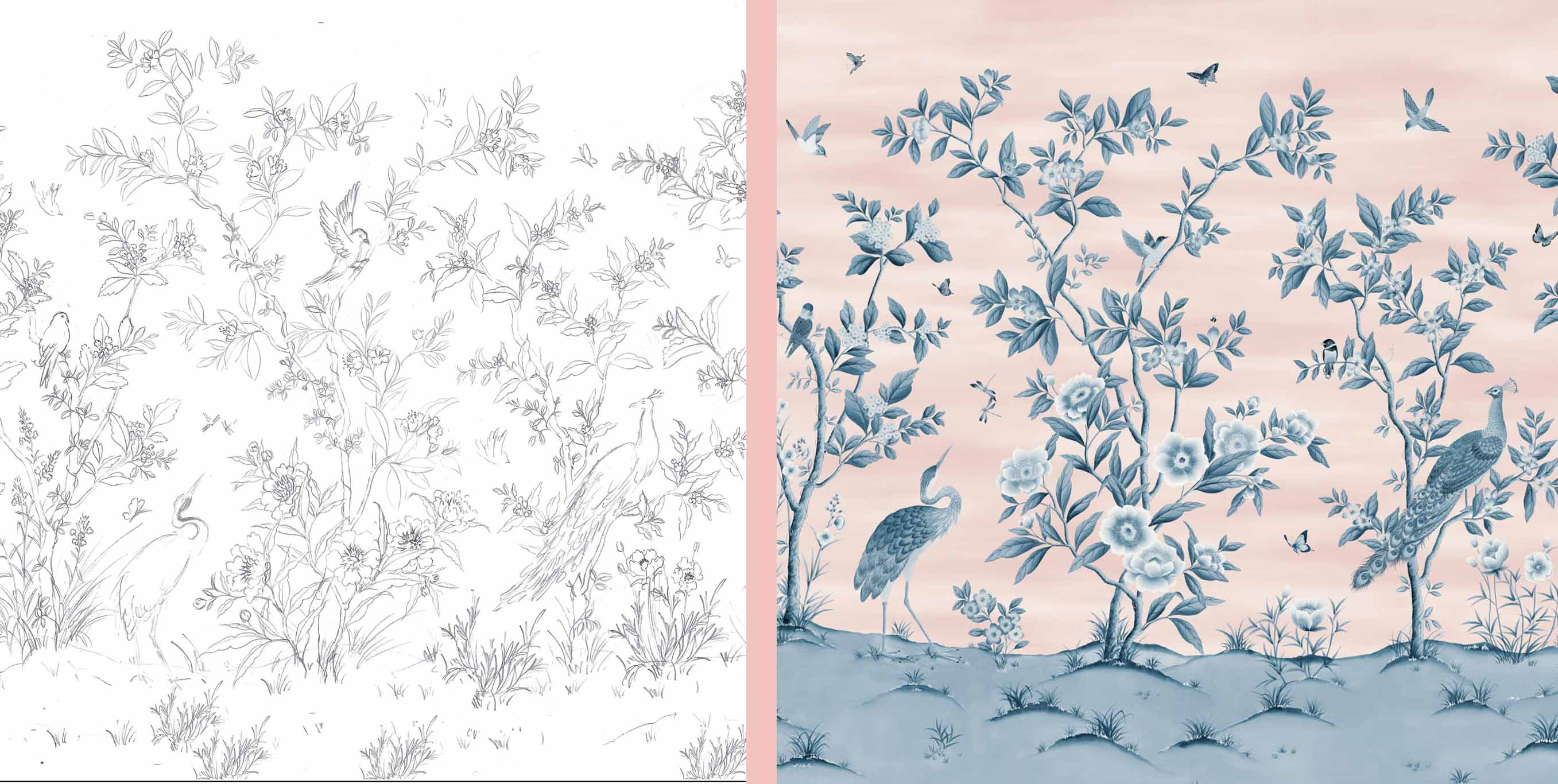

such a delight to get a wiff of the exciting world of decoration and design.
thanks so much for great pleasure.
These beautiful chinoiserie treasures were a pleasure to pour over. Living in a part of the world that has very little access to works of art like these I am especially grateful and excited to spend some time in this beautiful stylised world of so many years ago. Thank you once again Diane!
You seem to have overcome your ‘disaster’. So pleased for you.
Thank you for taking to time to write this lovely article and share your experience with these beautiful historical works of art. Chinoiserie is such a complex and interesting art form, and I love how it distills the experiences I have in my garden and nature to such an approachable and cheerful art. Your own work is gorgeous and absolutely belongs alongside that of the historical artists whose work can be seen at Brighton. Congratulations!
What an interesting read, thank you for sharing it all. I used to be an antique restorer and worked on many pieces of furntiure with Chinoiserie and Japanned decoration, but know little about the wallpaper.
Your delight is palpable. It must have been truly amazing to hold those original fragments, as it always is, seeing another artists work close up. Thank you so much for sharing such a precious experience.
A great read Diane. Lovely to get a feel for the history of Chinoiserie, also a great insight into the evolution of the style. Love your work.
An enjoyable read, Diane! Thanks for sharing about this wonderful art form and about your visit to Brighton Pavilion.
I loved this post! Reminded me of being back in design school – in the best way. Hearing about the particularities of chinoiserie; the realism v stylized elements, is fascinating. So glad you’re carrying on such a unique and special art form. AND getting due credit! :)